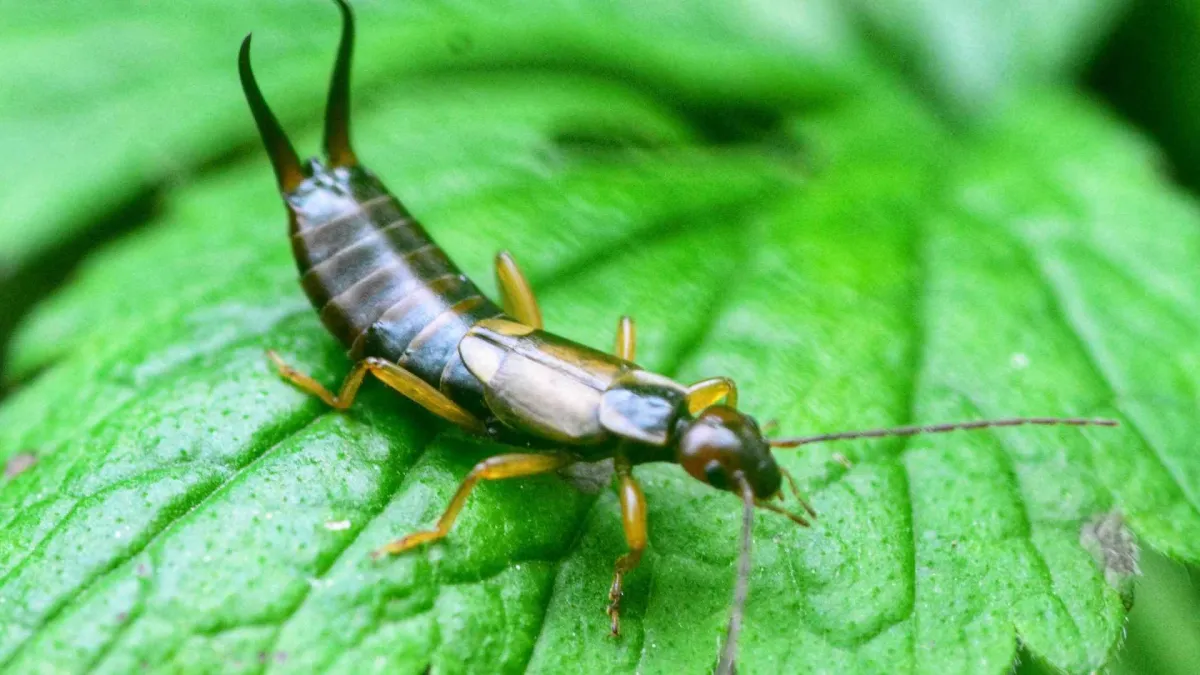Blog
Explore insightful and informative pest control blogs

Treatment for Earwigs in the Garden: Quick Tips
Earwigs can be both beneficial and detrimental in the garden.
Look for signs of earwig damage and presence to identify an infestation.
Utilize natural methods like diatomaceous earth, neem oil, and traps for control.
Consider insecticidal soaps or specific insecticides as a last resort, following safety guidelines carefully.
Earwigs, those creepy-crawlies with pincers on their behinds, can be a nuisance in the garden. While they do have some beneficial qualities, their fondness for feasting on your prized plants can be disheartening.
This comprehensive guide will equip you with the knowledge and strategies to effectively manage earwigs and keep your garden thriving.
Understanding Earwigs in the Garden
Earwigs are elongated insects with pincers (forceps) protruding from their rear ends. Despite their appearance, these pincers are relatively harmless to humans and are primarily used for defense and capturing prey.
Common habitats in the Garden
Earwigs are moisture-loving creatures and seek shelter in damp, dark places. In your garden, they'll likely be found under mulch, rocks, leaf litter, and around the base of plants. They're particularly active at night, so spotting them during the day might require some investigation.
Earwig Behavior
Nocturnal activities: As mentioned before, earwigs are nocturnal insects. They emerge from their hiding spots under the cover of darkness to forage for food.
Feeding habits and diet: Earwigs are omnivores, with a diet that includes decaying plant matter, insects like aphids, and even tender plant leaves and petals.
Impact on the Garden
Beneficial aspects (e.g., pest control): Earwigs can actually be beneficial predators, helping to control populations of aphids and other small garden pests.
Harmful effects on plants: Unfortunately, earwigs also enjoy munching on the leaves, flowers, and fruits of your vegetables, flowers, and ornamentals. The damage often appears as ragged holes or irregular feeding patterns on leaves and petals.
Identifying Earwig Infestation

If you suspect earwigs are munching on your garden bounty, here are some signs to watch out for:
Signs of Earwig Presence
Visible damage to plants: Look for ragged holes or irregular feeding patterns on leaves, flowers, and fruits.
Droppings and shed skins: Earwigs leave behind tiny, dark droppings and shed skins as they move around.
Observation during nighttime: If you go out to your garden at night with a flashlight, you might spot earwigs actively feeding on your plants.
Common Plants Affected
Earwigs are particularly attracted to moist and tender vegetation. Some of their favorite targets include:
Hostas
Dahlias
Zinnias
Beets
Strawberries
The damage they cause can vary depending on the plant, but it often involves chewed leaves, wilting flowers, and blemishes on fruits.
Call us to protect your garden from earwigs effectively!
Effective Pest Control Methods for Earwigs

There are several ways to combat earwigs in your garden, from natural options to chemical solutions. Let's explore some effective methods:
Natural Treatment Options
Diatomaceous Earth: This fine, powdery substance made from fossilized algae dehydrates earwigs' exoskeletons, leading to their death. Apply a thin layer of diatomaceous earth around the base of plants and in areas where earwigs hide.
Neem Oil: This natural oil extracted from the neem tree has insecticidal properties that repel and suffocate earwigs. Mix neem oil with water according to the product label and spray directly on plants and their surrounding areas. Reapply every 7-10 days, especially after rain.
Traps
Traps are a great way to capture and remove existing earwigs from your garden. Here are two popular options:
Rolled-up newspaper: Provide earwigs with a cozy hiding spot by rolling up old newspapers and placing them around your plants. Check the traps daily and dispose of any captured earwigs.
Oil traps: Fill shallow containers with vegetable oil or a mixture of soy sauce and oil. Earwigs will be attracted to the scent and drown in the oil.
Chemical Treatment Options
If natural methods aren't proving effective, consider using insecticidal soaps or commercially available insecticides specifically labeled for earwigs.
Insecticidal Soaps: These soaps kill earwigs on contact by disrupting their cell membranes. When using insecticidal soaps, always follow the instructions on the product label and ensure proper safety gear like gloves and eye protection.
Commercial Insecticides: Several insecticides target earwigs. Look for products containing cyfluthrin, lambda-cyhalothrin, or pyrethrins. Always read and follow the label instructions carefully when using any chemical insecticide.
If you have a severe infestation it’s always better to hire a residential pest control service to get rid of earwigs.
Reach out to us for reliable and efficient earwig control services!
Preventing Future Infestations

The best way to deal with earwigs is to prevent them from establishing themselves in your garden in the first place. Here are some preventative measures you can take:
Garden Maintenance Tips
Regular cleaning and debris removal: Eliminate potential hiding spots for earwigs by regularly removing leaf litter, fallen branches, and other garden debris.
Proper watering techniques: Avoid overwatering your plants, as earwigs thrive in moist environments. Water deeply and less frequently to encourage healthy root growth and discourage moisture buildup.
Barrier Methods
Creating physical barriers around plants: You can use petroleum jelly or a band of Vaseline around the base of plant stems to create a sticky barrier that deters earwigs from climbing up.
Using mulch and ground covers: While mulch can provide harborage for earwigs, using a thin layer of organic mulch (around 2-3 inches) at a distance from the plant stem can actually help suppress weed growth and retain moisture, making your garden less hospitable to them in the long run. Alternatively, consider using inorganic mulches like gravel around vulnerable plants.
Attracting Natural Predators
Beneficial insects that prey on earwigs: Encourage the presence of beneficial insects like spiders, ground beetles, and parasitic wasps in your garden. These natural predators can help keep earwig populations in check.
Encouraging a balanced garden ecosystem: Maintaining a diverse and healthy garden ecosystem with a variety of flowering plants will attract beneficial insects and promote a natural balance that deters pest outbreaks.
Contact us today for professional earwig treatment in your garden!
Monitoring and Long-term Pest Control Strategies

Keeping a watchful eye on your garden is key to early detection and intervention. Schedule regular inspections to look for signs of earwig damage or the presence of the insects themselves.
Keeping a garden log: Documenting your observations in a garden log can be extremely helpful. Note down any signs of earwig activity, the methods you use to control them, and their effectiveness. This information can be invaluable in monitoring progress and adapting your strategies over time.
Adapting Strategies
Assessing the effectiveness of treatments: Evaluate the success of your chosen methods. If you're not seeing a reduction in earwig activity or damage, it might be time to try a different approach.
Adjusting methods based on results: Being flexible and adapting your strategies based on the results you see is crucial for long-term pest control success.
Integrated Pest Management (IPM)
Combining various approaches for sustainable control: Integrated Pest Management (IPM) encourages a multi-pronged approach that combines natural, mechanical, and (if necessary) chemical methods to manage pest populations. This approach aims for sustainable control with minimal impact on the environment.
Benefits of IPM in garden health: By promoting a healthy and balanced garden ecosystem, IPM helps to create a more resilient environment that can naturally resist pest infestations.
Final Thoughts and Recommendations
As a pest control expert, I can assure you that with the right knowledge and strategies, you can effectively manage earwigs in your garden. Remember, a combination of prevention, monitoring, and a variety of control methods is key to achieving long-term success.
Be proactive in your garden management. Early detection and intervention are key to keeping earwig populations under control. Don't be discouraged if you don't see immediate results – achieving long-term pest control often requires a combination of methods and consistent effort.
Frequently Asked Questions About Treatment for Earwigs in the Garden
How do I get rid of earwigs in my garden?
To get rid of earwigs in your garden, use a combination of natural remedies and chemical treatments, such as diatomaceous earth, neem oil, and insecticidal soaps.
Why are there so many earwigs in my garden?
There are so many earwigs in your garden because they thrive in moist, dark environments and feed on decaying plant matter and insects.
Do coffee grounds repel earwigs?
Coffee grounds do not effectively repel earwigs, although they can improve soil quality.
What can I spray to keep earwigs away?
To keep earwigs away, you can spray neem oil or a mixture of water and dish soap directly on affected plants.
Craving a Superior Pest Control Solution?
COMPANY STORY
& EXPERIENCE
Craig Broadhead started his pest business in 2004 in California, called Pacific Pest Control. In 2021, he sold his business and moved his family to Arkansas to start fresh with a new vision of Network Pest Control. His goal it to make sure each customer has the best experience possible.


Network Pest Control
11205 Meadow Lark Rd. Rogers AR 72756
479.888.4249
